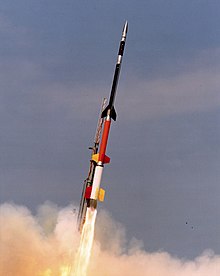
Back صاروخ تجارب Arabic Meteoroloji raket Azerbaijani Coet sonda Catalan Sondážní raketa Czech Höhenforschungsrakete German Sonda raketo Esperanto Cohete sonda Spanish Suziri-zunda Basque موشک ژرفاسنج Persian Luotainraketti Finnish

A sounding rocket or rocketsonde, sometimes called a research rocket or a suborbital rocket, is an instrument-carrying rocket designed to take measurements and perform scientific experiments during its sub-orbital flight. The rockets are used to launch instruments from 48 to 145 km (30 to 90 miles)[1] above the surface of the Earth, the altitude generally between weather balloons and satellites; the maximum altitude for balloons is about 40 km (25 miles) and the minimum for satellites is approximately 121 km (75 miles).[2] Certain sounding rockets have an apogee between 1,000 and 1,500 km (620 and 930 miles), such as the Black Brant X and XII, which is the maximum apogee of their class. Sounding rockets often use military surplus rocket motors.[3] NASA routinely flies the Terrier Mk 70 boosted Improved Orion, lifting 270–450-kg (600–1,000-pound) payloads into the exoatmospheric region between 97 and 201 km (60 and 125 miles).[4]
- ^ nasa.gov NASA Sounding Rocket Program Handbook, June 2005, p. 1
- ^ "NASA Sounding Rocket Program Overview". NASA Sounding Rocket Program. NASA. 24 July 2006. Retrieved 10 October 2006.
- ^ Cite error: The named reference
whatwas invoked but never defined (see the help page). - ^ NASA Sounding Rocket Handbook
© MMXXIII Rich X Search. We shall prevail. All rights reserved. Rich X Search